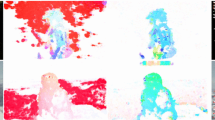Abstract
Purpose
Context-aware systems for the operating room (OR) provide the possibility to significantly improve surgical workflow through various applications such as efficient OR scheduling, context-sensitive user interfaces, and automatic transcription of medical procedures. Being an essential element of such a system, surgical action recognition is thus an important research area. In this paper, we tackle the problem of classifying surgical actions from video clips that capture the activities taking place in the OR.
Methods
We acquire recordings using a multi-view RGBD camera system mounted on the ceiling of a hybrid OR dedicated to X-ray-based procedures and annotate clips of the recordings with the corresponding actions. To recognize the surgical actions from the video clips, we use a classification pipeline based on the bag-of-words (BoW) approach. We propose a novel feature encoding method that extends the classical BoW approach. Instead of using the typical rigid grid layout to divide the space of the feature locations, we propose to learn the layout from the actual 4D spatio-temporal locations of the visual features. This results in a data-driven and non-rigid layout which retains more spatio-temporal information compared to the rigid counterpart.
Results
We classify multi-view video clips from a new dataset generated from 11-day recordings of real operations. This dataset is composed of 1734 video clips of 15 actions. These include generic actions (e.g., moving patient to the OR bed) and actions specific to the vertebroplasty procedure (e.g., hammering). The experiments show that the proposed non-rigid feature encoding method performs better than the rigid encoding one. The classifier’s accuracy is increased by over 4 %, from 81.08 to 85.53 %.
Conclusion
The combination of both intensity and depth information from the RGBD data provides more discriminative power in carrying out the surgical action recognition task as compared to using either one of them alone. Furthermore, the proposed non-rigid spatio-temporal feature encoding scheme provides more discriminative histogram representations than the rigid counterpart. To the best of our knowledge, this is also the first work that presents action recognition results on multi-view RGBD data recorded in the OR.







Similar content being viewed by others
References
Barrera F, Padoy N (2014) Piecewise planar decomposition of 3d point clouds obtained from multiple static RGB-D cameras. In: International conference on 3D vision (3DV)
Bhatia B, Oates T, Xiao Y, Hu PFM (2007) Real-time identification of operating room state from video. In: AAAI, AAAI Press, pp 1761–1766
Blum T, Feussner H, Navab N (2010) Modeling and segmentation of surgical workflow from laparoscopic video. In: MICCAI (3), Springer, pp 400–407
Chakraborty I, Elgammal A, Burd RS (2013) Video based activity recognition in trauma resuscitation. In: 10th IEEE international conference and workshops on automatic face and gesture recognition (FG), pp 1–8
Choi J, Jeon WJ, Lee SC (2008) Spatio-temporal pyramid matching for sports videos. In: MIR, ACM, pp 291–297
Dollár P, Rabaud V, Cottrell G, Belongie S (2005) Behavior recognition via sparse spatio-temporal features. In: VS-PETS
Jhuang H, Gall J, Zuffi S, Schmid C, Black MJ (2013) Towards understanding action recognition. In: ICCV, IEEE, pp 3192–3199
Kadkhodamohammadi A, Gangi A, de Mathelin M, Padoy N (2014) Temporally consistent 3d pose estimation in the interventional room using discrete MRF optimization over RGBD sequences. In: IPCAI, pp 168–177
Krapac J, Verbeek J, Jurie F (2011) Modeling spatial layout with fisher vectors for image categorization. In: ICCV, IEEE, pp 1487–1494
Lalys F, Riffaud L, Bouget D, Jannin P (2012) A framework for the recognition of high-level surgical tasks from video images for cataract surgeries. IEEE Trans Biomed Eng 59(4):966–976
Laptev I, Marszałek M, Schmid C, Rozenfeld B (2008) Learning realistic human actions from movies. In: CVPR
Lazebnik S, Schmid C, Ponce J (2006) Beyond bags of features: Spatial pyramid matching for recognizing natural scene categories. In: CVPR, pp 2169–2178
Lea C, Facker JC, Hager GD, Taylor RH, Saria S (2013) 3d sensing algorithms towards building an intelligent intensive care unit. In: AMIA summits on translational science proceedings
Loy Rodas N, Padoy N (2015) Seeing is believing: increasing intraoperative awareness to scattered radiation in interventional procedures by combining augmented reality, Monte Carlo simulations and wireless dosimeters. Int J Comput Assist Radiol Surg. doi:10.1007/s11548-015-1161-x
Padoy N, Mateus D, Weinland D, Berger MO, Navab N (2009) Workflow monitoring based on 3D motion features. In: Workshop on video-oriented object and event classification in conjunction with ICCV 2009, pp 585–592
Padoy N, Blum T, Ahmadi SA, Feussner H, Berger MO, Navab N (2012) Statistical modeling and recognition of surgical workflow. Med Image Anal 16(3):632–641
Twinanda AP, Marescaux J, Mathelin MD, Padoy N (2014) Towards better laparoscopic video database organization by automatic surgery classification. In: IPCAI, pp 186–194
Vedaldi A, Fulkerson B (2010) Vlfeat: an open and portable library of computer vision algorithms. In: ICM, ACM, pp 1469–1472
Xia L, Aggarwal J (2013) Spatio-temporal depth cuboid similarity feature for activity recognition using depth camera. In: CVPR
Yang J, Yu K, Gong Y, Huang T (2009) Linear spatial pyramid matching using sparse coding for image classification. In: CVPR
Zappella L, Bejar B, Hager G, Vidal R (2013) Surgical gesture classification from video and kinematic data. Med Image Anal 17(7):732–745
Acknowledgments
This work was supported by the French ANR within the Investissements d’Avenir program under references ANR-11-LABX-0004 (Labex CAMI), ANR-10-IDEX-0002-02 (IdEx Unistra), and ANR-10-IAHU-02 (IHU Strasbourg). The authors would like to thank the medical staff of the Interventional Radiology Department at Nouvel Hôpital Civil Strasbourg for their collaboration during the data acquisition process.
Author information
Authors and Affiliations
Corresponding author
Rights and permissions
About this article
Cite this article
Twinanda, A.P., Alkan, E.O., Gangi, A. et al. Data-driven spatio-temporal RGBD feature encoding for action recognition in operating rooms. Int J CARS 10, 737–747 (2015). https://doi.org/10.1007/s11548-015-1186-1
Received:
Accepted:
Published:
Issue Date:
DOI: https://doi.org/10.1007/s11548-015-1186-1




